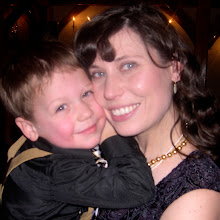
Recently, I've been reading
Pocketful of Pinecones (great book BTW) and mulling over the whole Charlotte Mason style emphasis on Nature Study.
Nature is fun. It is interesting.
So, why do so many of us avoid teaching it? Okay, to be more real, why do we (we meaning "I") avoid nature all-together? Why do we sit snug in our warm homes thinking that it is just too much of a bother?
I think I've made nature too complicated. I can't even tell you how many times have I decided to be "intentional" about enjoying nature with the kids. I've bought books about it, collected art supplies & backpacks, packed lunches, and tromped the little ones an hour into the woods just to hear "I need to go potty!"
Enough!
I somehow have created this idea that NATURE is only located far away from home and we need to be actively pursuing it. How ludicrous!
Whatever happened to kids playing in the rain?
Or
Catching bugs?
Or
Pulling the bark off of a tree branch?
Or
Just sitting outside doing nothing at all?
Nature shouldn't be made boring by over scheduling.
Nature shouldn't be made difficult by forcing kids to examine details when they are uninspired, write when they aren't able, or draw when they struggle with dexterity.
At the beginning of this school year I decided that I wanted to find a way to make nature study a joy for my kids, rather than another task to be done (and grumbled about), so nature study looks really different at my house now. It is intentionally tailored to my kids passions & strengths (photography for my boy and creative writing for my girl), avoiding our weaknesses (handwriting & drawing).
This is what I have found to work for us:
Day 1 - Enjoy nature
- Hike, look through a collection, observe the back yard, play in a mud puddle AKA - send the kids outside to play and don't tell them what to do (they love this part), but be diligent about asking questions about what/where they were playing when they come back in and make a mental note of their answer
- Allow kids to photograph items of interest, even if it is a poorly composed picture of mud
Day 2 - Research
- Based on their observations on Day 1, choose a photo and print it in Black & White for each child (we use sticker paper, but regular copy paper works great too). Google images is a great source if the kids aren't in a picture taking mood or the photos are too fuzzy
- Encourage kids to identify the subject themselves
- While kids color the photo (colored pencils work best), mom reads aloud about the subject from the internet, guide books, etc. but only while the kids are still interested - when they tune out, I stop. If they stay interested for 2 hours, we keep going for 2 hours (or at least until the baby wakes from her nap). We love using the FIAR digital nature studies . It is one of the highlights of our homeschool.
Day 3 - Write (or more specifically, Talk)
- Allow child to dictate a story about the subject they chose, using it as a character or setting. Whimsey and fiction are not only allowed in our house, but encouraged. (Burgess style - fiction with lots of accurate detail about nature) Mom types while the child talks.
Day 4 - Assemble Nature Journal
- Print dictation
- Ask child to copy as much as is age appropriate (sometimes we skip this, depending on the workload that week)
- Allow child to paste into their journal: dictation, copy-work, & photograph, - Usually the topic that they choose is something of interest to them so they will have a random assortment drawings, magazine clippings, leaves, notes, coloring pages, & internet images that they want to add too.
*I had photos of our journals to include, but I accidentally deleted them (blah). I'll try to add them again later.
We don't do this every week, simply because of time constraints, but it is a system that my family has been able to not only stick to, but enjoy and look forward to.
~ Got a good mud puddle near your house?






















































